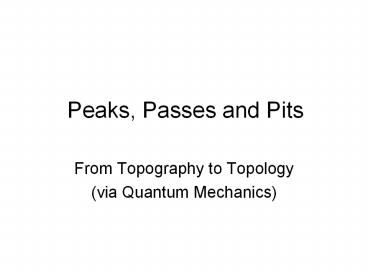Peaks, Passes and Pits - PowerPoint PPT Presentation
1 / 20
Title:
Peaks, Passes and Pits
Description:
From Topography to Topology (via Quantum Mechanics) James Clerk Maxwell, 1831-1879 1861 ... On the Dynamical Theory of the Electromagnetic Field 1870 ... – PowerPoint PPT presentation
Number of Views:113
Avg rating:3.0/5.0
Title: Peaks, Passes and Pits
1
Peaks, Passes and Pits
- From Topography to Topology
- (via Quantum Mechanics)
2
(No Transcript)
3
James Clerk Maxwell, 1831-1879
4
- 1861 On Physical Lines of Force
- 1864 On the Dynamical Theory of the
Electromagnetic Field - 1870 On Hills and Dales
- hilldale.pdf
5
(No Transcript)
6
Scottish examples
7
Peak
Pass
Pit
8
Critical points of a function on a surface
- Peaks (local maxima)
- Passes (saddle points)
- Pits (local minima)
- Can identify by looking at 2nd derivative
- Topology only changes when we pass through a
critical point.
9
(No Transcript)
10
Basic theorem
- ( Peaks) ( Passes) ( Pits) Euler
Characteristic (V-EF) - Euler Characteristic is a topological invariant
2 for the sphere 0 for the torus. - Does not depend on which Morse function we choose!
11
The Hodge equations
- The Euler characteristic can also be obtained by
counting solutions to certain partial
differential equations the Hodge equations. - They are geometrical analogs of Maxwells
equations! - To see how PDE can relate to topology, think
about vector fields and potentials
12
The physics connection
- Ed Witten, Supersymmetry and Morse Theory, 1982
13
Wittens method
- Consider the Hodge equation as a quantum
mechanical Hamiltonian. - Different types of particle according to the
Morse index (peakons, passons and pitons). - Euler characteristic given by counting the low
energy states of these particles.
14
(No Transcript)
15
Perturbation theory
- Replace d by esh d e-sh, where h is the Morse
function and s is a real parameter. - This perturbation does not change the number of
low energy states. - But it does change the Hodge equations!
16
- In fact, it introduces a potential term, which
forces our particles to congregate near the
critical points of appropriate index. - The potential is
- s2?h2 sXh
- where Xh is a zero order vectorial term.
17
- The term Xh has a zero point energy effect
which forces each type of particle to congregate
near the critical points of the appropriate
index peakons near peaks, passons near
passes and so on.
18
(No Transcript)
19
- Thus the number of low energy n-on modes
approaches the number of critical points of index
n, as the parameter s becomes large. - Appropriately formulated, this proves the
fundamental result of Morse theory peaks
passes pits Euler characteristic.
20
James Clerk Maxwell, 1831-1879































